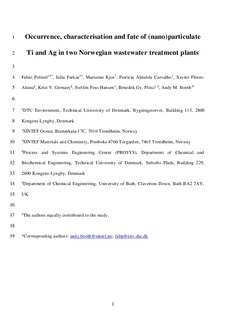| dc.contributor.author | Polesel, Fabio | |
| dc.contributor.author | Farkas, Julia | |
| dc.contributor.author | Kjos, Marianne Steinsvik | |
| dc.contributor.author | Almeida Carvalho, Patricia | |
| dc.contributor.author | Flores-Alsina, Xavier | |
| dc.contributor.author | Gernaey, Krist V. | |
| dc.contributor.author | Hansen, Steffen Foss | |
| dc.contributor.author | Plosz, Benedek | |
| dc.contributor.author | Booth, Andy | |
| dc.date.accessioned | 2018-08-16T15:38:54Z | |
| dc.date.available | 2018-08-16T15:38:54Z | |
| dc.date.created | 2018-04-28T16:43:40Z | |
| dc.date.issued | 2018-09-15 | |
| dc.identifier.citation | Water Research. 2018, 141 19-31. | nb_NO |
| dc.identifier.issn | 0043-1354 | |
| dc.identifier.uri | http://hdl.handle.net/11250/2558339 | |
| dc.description.abstract | Due to their widespread application in consumer products, elemental titanium (e.g., titanium dioxide, TiO2) and silver (Ag), also in nanoparticulate form, are increasingly released from households and industrial facilities to urban wastewater treatment plants (WWTPs). A seven-day sampling campaign was conducted in two full-scale WWTPs in Trondheim (Norway) employing only primary treatment. We assessed the occurrence and elimination of Ti and Ag, and conducted size-based fractionation using sequential filtration of influent samples to separate particulate, colloidal and dissolved fractions. Eight-hour composite influent samples were collected to assess diurnal variations in total Ti and Ag influx. Measured influent Ti concentrations (up to 290 µg L-1) were significantly higher than Ag (<0.15–2.1 µg L-1), being mostly associated with suspended solids (>0.7 µm). Removal efficiencies ≥70% were observed for both elements, requiring for one WWTP to account for the high Ti content (~2 g L-1) in the flocculant. Nano- and micron-sized Ti particles were observed with scanning transmission electron microscopy (STEM) in influent, effluent and biosolids, while Ag nanoparticles were detected in biosolids only. Diurnal profiles of influent Ti were correlated to flow and pollutant concentration patterns (especially total suspended solids), with peaks during the morning and/or evening and minima at night, indicating household discharges as predominant source. Irregular profiles were exhibited by influent Ag, with periodic concentration spikes suggesting short-term discharges from one or few point sources (e.g., industry). Influent Ti and Ag dynamics were reproduced using a disturbance scenario generator model, and we estimated per capita loads of Ti (42–45 mg cap-1 d-1) and Ag (0.11 mg cap-1 d-1) from households as well as additional Ag load (14–22 g d-1) from point discharge. This is the first study to experimentally and mathematically describe short-term release dynamics and dry-weather sources of emissions of Ti and Ag in municipal WWTPs and receiving environments. | nb_NO |
| dc.description.abstract | Occurrence, characterisation and fate of (nano)particulate Ti and Ag in two Norwegian wastewater treatment plants | nb_NO |
| dc.language.iso | eng | nb_NO |
| dc.publisher | Elsevier | nb_NO |
| dc.relation.uri | https://doi.org/10.1016/j.watres.2018.04.065 | |
| dc.rights | Attribution-NonCommercial-NoDerivatives 4.0 Internasjonal | * |
| dc.rights.uri | http://creativecommons.org/licenses/by-nc-nd/4.0/deed.no | * |
| dc.subject | Nanoparticles | nb_NO |
| dc.subject | Titanium dioxide | nb_NO |
| dc.subject | Silver | nb_NO |
| dc.subject | Wastewater | nb_NO |
| dc.subject | Diurnal variation | nb_NO |
| dc.subject | Modelling | nb_NO |
| dc.title | Occurrence, characterisation and fate of (nano)particulate Ti and Ag in two Norwegian wastewater treatment plants | nb_NO |
| dc.title.alternative | Occurrence, characterisation and fate of (nano)particulate Ti and Ag in two Norwegian wastewater treatment plants | nb_NO |
| dc.type | Journal article | nb_NO |
| dc.type | Peer reviewed | nb_NO |
| dc.description.version | acceptedVersion | nb_NO |
| dc.rights.holder | © 2018 Elsevier Ltd. All rights reserved. - postprint version © The Authors 2018 | nb_NO |
| dc.subject.nsi | VDP::Bioteknologi: 590 | nb_NO |
| dc.subject.nsi | VDP::Biotechnology: 590 | nb_NO |
| dc.source.pagenumber | 19-31 | nb_NO |
| dc.source.volume | 141 | nb_NO |
| dc.source.journal | Water Research | nb_NO |
| dc.identifier.doi | 10.1016/j.watres.2018.04.065 | |
| dc.identifier.cristin | 1582314 | |
| dc.relation.project | Norges forskningsråd: 238972 | nb_NO |
| cristin.unitcode | 7566,6,0,0 | |
| cristin.unitcode | 7401,80,1,3 | |
| cristin.unitcode | 7401,80,62,0 | |
| cristin.unitname | Miljø og nye ressurser | |
| cristin.unitname | Massespektrometri | |
| cristin.unitname | Bærekraftig energiteknologi | |
| cristin.ispublished | true | |
| cristin.fulltext | postprint | |
| cristin.qualitycode | 2 | |

